A Novel Approach for Assessing the Performance of Offshore Ground Improvement in Floating Storage and Regasification Unit (FSRU) Terminal Construction
Abstract
:1. Introduction
2. Characterization of the Study Area
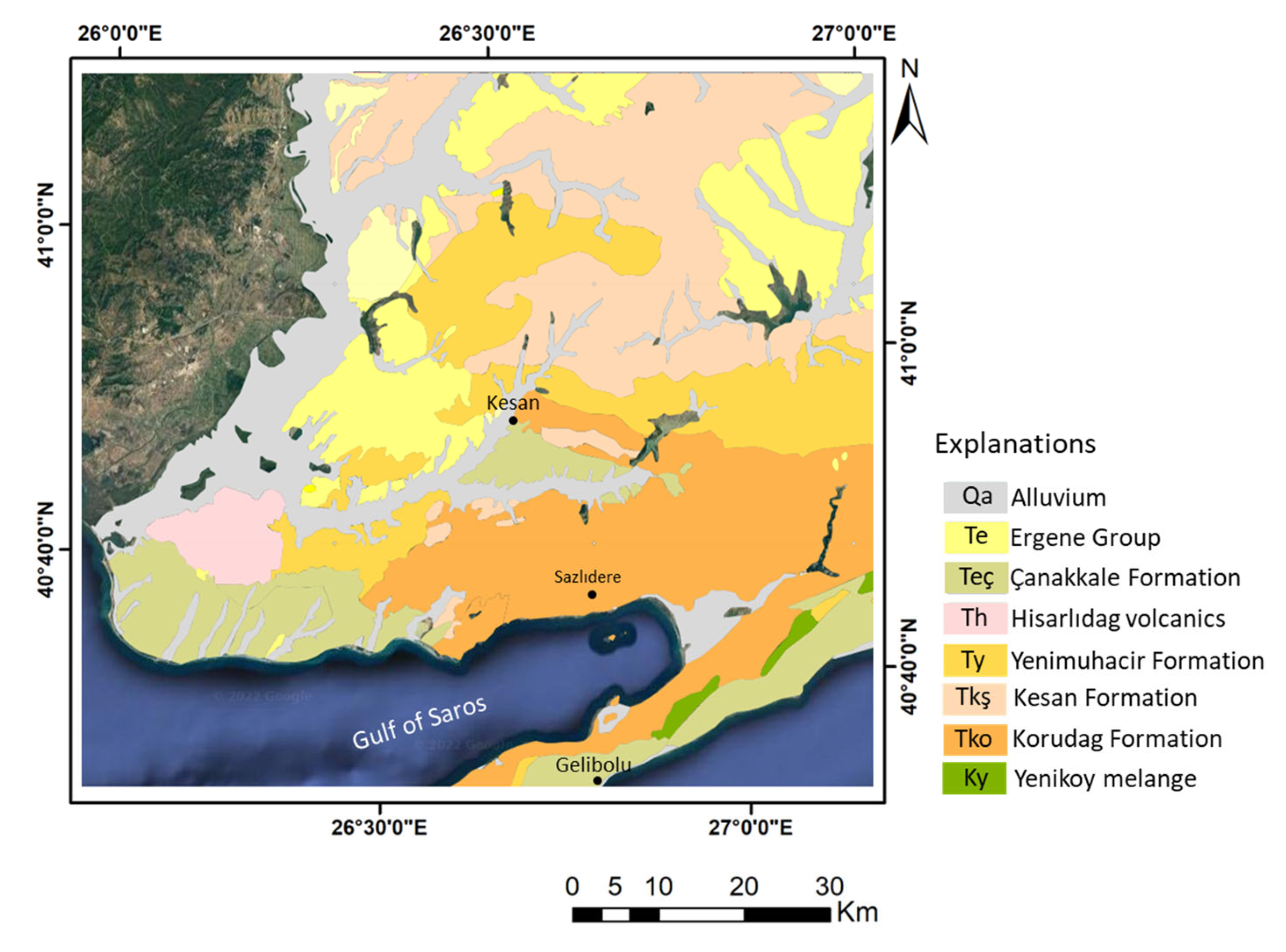
3. Geotechnical Site Investigations and Liquefaction Analysis
4. Design of Jet Columns
- Gr: the shear modulus ratio,
- ar: area replacement ratio,
- Gsj: shear modulus of jet-column,
- Gs: shear modulus of soil
5. Methodology for Quality Control of Jet Columns
- (a)
- Before any jet grouting is performed, the entire area is measured using the seismic method while the site is in virgin conditions. The measurements obtained are evaluated together with the data obtained from the offshore boreholes.
- (b)
- Jet grout columns are constructed, and seismic measurements are obtained again. The seismic measurement results of both the virgin field and the field where the columns are constructed are compared.
- (c)
- Each improved area is measured with the seismic method before the filling work continues, after which it is concluded that the improvement is successful.
6. Conclusions
- (a)
- For geotechnical site characterization, a total of 10 offshore geotechnical boreholes were drilled and detailed seismic reflection profiles were obtained. The detailed stratigraphic sections and their geotechnical parameters of the seabed sediments were obtained. The seabed stratigraphy and their geotechnical parameters are generally homogenous. This feature of the project site decreases the geotechnical uncertainty.
- (b)
- The seabed sediments in the project area are susceptible to liquefaction. As a result of liquefaction analysis, the factor of safety was calculated as 0.04–0.29 for natural conditions. For ground improvement methods, the jet grout column construction was considered. The targeted uniaxial compressive strength of the jet grout columns was 3 MPa, and the pattern of the columns was designed as 2 m × 2 m. When considering this design, the minimum factor of safety was obtained as 1.01.
- (c)
- In the first stage of the jet grout construction works, various trial columns were constructed, and the optimum jet parameters were determined. Injection pressure, withdrawal speed, and amount of cement were determined as 420 bar, 40 cm/min, and 2200 kg, respectively. The minimum and maximum uniaxial compressive strength values of the core specimens obtained from the jet columns were found to be 2.71 MPa–4.51 MPa. As a result, the improved parameters considered in the design were achieved.
- (d)
- Determination of jet grout dimensions constructed in a terrestrial environment is relatively easy when compared to jet grout dimensions constructed in an offshore environment. For this reason, new applicable approaches for this purpose are necessary. Hence, in the study, a new procedure for the determination of jet grout dimensions constructed in an offshore environment is introduced.
- (e)
- The methodology is based on the shallow seismic reflection method. The whole area is measured by seismic method while the site is in virgin conditions. The measurement results are assessed together with the data obtained from the offshore boreholes. After this stage, jet grout columns are constructed, and seismic measurements are obtained again. The jet grout dimensions are determined by employing the shallow reflection method. The results are checked by boreholes and observed by the divers visually and it is determined that the results are satisfactory.
- (f)
- While the quality control of jet grouts can be carried out on a certain number of columns with conventional methods, the dimensions of all columns can be controlled with the method proposed in this study. In addition, the method is non-destructive on the columns, it is easier, and faster to apply.
- (g)
- The most important limitation of the method proposed herein is that the strength parameters of the jet columns cannot be obtained directly. For this purpose, core samples must be obtained from test columns and a limited number of control drillings.
- (h)
- The methodology is introduced by employing one project. Depending on the development of technology and increase in the number of projects, the method can be advanced, and the reliability of the method can be increased.
- (i)
- In a numerical analysis, the larger vertical deformation values are determined for unimproved ground, while the vertical deformation values calculated for mitigated ground are significantly reduced. The finite element analysis results obviously show the importance of soil improvement against liquefaction.
Author Contributions
Funding
Institutional Review Board Statement
Informed Consent Statement
Data Availability Statement
Acknowledgments
Conflicts of Interest
References
- Semaskaite, V.; Bogdevicius, M.; Paulauskiene, T.; Uebe, J.; Filina-Dawidowicz, L. Improvement of Regasification Process Efficiency for Floating Storage Regasification Unit. J. Mar. Sci. Eng. 2022, 10, 897. [Google Scholar] [CrossRef]
- Martins, M.; Pestana, M.; Souza, G.; Schleder, A. Quantitative risk analysis of loading and offloading liquefied natural gas (LNG) on a floating storage and regasification unit (FSRU). J. Loss Prev. Process. Ind. 2016, 43, 629–653. [Google Scholar] [CrossRef]
- Stone, R.C.; Farhangi, V.; Fatahi, B.; Karakouzian, M. A novel short pile foundation system bonded to highly cemented layers for settlement control. Can. Geotech. J. 2023. [Google Scholar] [CrossRef]
- Hinze, J.O. Turbulence; McGraw-Hill: New York, NY, USA, 1948. [Google Scholar]
- Modoni, G.; Croce, P.; Mongiovi, L. Theoretical modelling of jet grouting. Geotechnique 2006, 56, 335–347. [Google Scholar] [CrossRef]
- Kirsh, K.; Bell, A. Ground Improvement; CRC Press: Boca Raton, FL, USA, 2013; p. 494. [Google Scholar]
- Croce, P.; Flora, A.; Modoni, G. Jet Grouting Technology, Design and Control; CRC Press: London, UK, 2014. [Google Scholar] [CrossRef] [Green Version]
- Han, L. Principles and Practices of Ground Improvement; Wiley: New York, NY, USA, 2015; p. 418. [Google Scholar]
- Njock, P.G.A.; Chen, J.; Modoni, G.; Arulrajah, A.; Kim, Y.-H. A review of jet grouting practice and development. Arab. J. Geosci. 2018, 11, 459. [Google Scholar] [CrossRef]
- Akin, M.; Akkaya, I.; Akin, M.K.; Özvan, A.; Ak, Y. Impact of Jet-Grouting Pressure on the Strength and Deformation Characteristics of Sandy and Clayey Soils in the Compression Zone. KSCE J. Civ. Eng. 2019, 23, 3340–3352. [Google Scholar] [CrossRef]
- Olgun, M.; Kanat, A.; Senkaya, A.; Erkan, H. Investigating the properties of jet grouting columns with fine-grained cement and silica fume. Constr. Build. Mater. 2021, 267, 120637. [Google Scholar] [CrossRef]
- Liu, W. The application of high-pressure rotary jet grouting curtain on the ocean engineering structure. IOP Conf. Series: Earth Environ. Sci. 2021, 651, 042060. [Google Scholar] [CrossRef]
- Kutzner, C. Grouting of Rock and Soil; Balkema: Rotterdam, The Netherlands, 1996; p. 271. [Google Scholar]
- Lunardi, P. Ground Improvement by Means of Jet-Grouting. Proc. Inst. Civ. Eng.—Ground Improv. 1997, 1, 65–85. [Google Scholar] [CrossRef]
- Japanese Jet Grouting Association. Jet Grouting Technology: JSG Method, Column Jet Grouting Method, 13th ed.; Technical Information of the Japanese Jet Grouting Association; English translation; JJGA: Tokyo, Japan, 2005; p. 80. [Google Scholar]
- Croce, P.; Flora, A. Analysis of single-fluid jet grouting. Geotechnique 2006, 50, 739–748. [Google Scholar] [CrossRef]
- Tinoco, J.; Correia, A.G.; Cortez, P. Jet grouting column diameter prediction based on a data-driven approach. Eur. J. Environ. Civ. Eng. 2016, 22, 338–358. [Google Scholar] [CrossRef]
- Lombardi, G. The role of cohesion in cement grouting of rock. In Proceedings of the International Congress on Large Dams, Lausanne, Switzerland, 24–28 June 1985. Q. 58, R. 13. [Google Scholar]
- Bruce, D.A.; Littlejohn, G.S.; Naudts, A.M.C. Grouting materials for ground treatment: A practitioner’s guide. In Grouting: Compaction, Remediation and Testing; Vipulanandan, C., Ed.; ASCE: New York, NY, USA, 1997. [Google Scholar]
- Woodward, J. Introduction to Geotechnical Processes; CRC Press: Boca Raton, FL, USA, 2005. [Google Scholar]
- Maag, E. Ueber die Vergestigung und Dichtung das Baugrundes (Injektionen); Erdbaukers der ETH; Swiss Federal Institute of Technology: Zurich, Switzerland, 1938. [Google Scholar]
- Yoshida, H.; Jimbo, S.; Uesawa, S. Development and practical applications of large diameter soil improvement method. In Proceedings of the Conference on Grouting and Deep Mixing, Tokyo, Japan, 14–17 May 1996; pp. 721–726. [Google Scholar]
- Shibazaki, M.; Yokoo, M.; Yoshida, H. Development of oversized jet grouting. In Proceedings of the 3rd International Conference on Grouting and Ground Treatment, New Orleans, LA, USA, 10–12 February 2003; Volume 1, pp. 294–302. [Google Scholar]
- Shen, S.L.; Luo, C.Y.; Xiao, X.C.; Wang, J.L. Improvement Efficacy of RJP Method in Shanghai Soft Deposit: Advances in Ground Improvement, Research to Practice in the United States and China; Han, J., Zheng, G., Schaefer, V.R., Huang, M.S., Eds.; Geotechnical Special Publication: Reston, VA, USA, 2009; pp. 170–178. [Google Scholar]
- Morey, J.; Campo, D.W. Quality control of jet grouting on the Cairo metro. Proc. Inst. Civ. Engineers—Ground Improv. 1999, 3, 67–75. [Google Scholar] [CrossRef]
- Ni, J.C.; Cheng, W.-C. Quality control of double fluid jet grouting below groundwater table: Case history. Soils Found. 2014, 54, 1039–1053. [Google Scholar] [CrossRef] [Green Version]
- Guerreros, J.C.G.; Mackens, S.; Niederleithinger, E.; Fechner, T.H. Numerical Simulations of Crosshole and Downhole Seismic Measurements as Quality Control Tool for Jet Grout Columns. In Fundamentals to Applications in Geotechnical; IOS Press: Amsterdam, The Netherlands, 2015; pp. 985–992. [Google Scholar] [CrossRef]
- Farhangi, V.; Karakouzian, M.; Geertsema, M. Effect of Micropiles on Clean Sand Liquefaction Risk Based on CPT and SPT. Appl. Sci. 2020, 10, 3111. [Google Scholar] [CrossRef]
- Durgunoğlu, T.; Kulaç, F.; İkiz, S.; Sevim, O.; Akçakal, O. Offshore jet grouting—A case study. In Proceedings of the ISSMGE-TC 211 International Symposium on Ground Improvement (IS-GI Brussels), Brussels, Belgium, 31 May–1 June 2012. [Google Scholar]
- Lin, C.H.; Lin, C.P.; Dai, Y.Z.; Chien, C.Z. Application of surface wave method in assessment of ground modification with improvement columns. J. Appl. Geophys. 2017, 142, 14–22. [Google Scholar] [CrossRef]
- Guerreros, J.C.G.; Niederleithinger, E.; Mackens, S.; Fechner, T. Crosshole and downhole seismics: A new quality assurance tool for jet grout columns. Near Surf. Geophys. 2016, 14, 493–501. [Google Scholar] [CrossRef]
- Kurt, H.; Demirbag, E.; Kuşçu, I. Active submarine tectonism and formation of the Gulf of Saros, Northeast Aegean Sea, inferred from multi-channel seismic reflection data. Mar. Geol. 2000, 165, 13–26. [Google Scholar] [CrossRef]
- Saner, S. Saroz körfezi dolayının çökelme istifleri ve tektonik yerlesimi, Kuzeydoğu Ege Denizi, Türkiye. Türkiye Jeol. Kurumu Bülteni 1985, 28, 1–10. [Google Scholar]
- Tüysüz, O.; Barka, A.; Yiğitbaş, E. Geology of the Saros graben and its implications for the evolution of the North Anatolian fault in the Ganos–Saros region, northwestern Türkiye. Tectonophysics 1998, 293, 105–126. [Google Scholar] [CrossRef]
- Yaltırak, C. Tectonic history of the Ganos Fault System. Turk. Assoc. Pet. Geol. Bull. 1996, 8, 137–156, (In Turkish, with English abstract). [Google Scholar]
- Vardar, D. Evidence for active faulting in the eastern part of the Gulf of Saros, northern Aegean, from high-resolution seismic data. J. Earth Syst. Sci. 2019, 128, 52. [Google Scholar] [CrossRef] [Green Version]
- Çağatay, M.N.; Gorür, N.; Alpar, B.; Saatçılar, R.; Akkök, R.; Sakınç, M.; Yaltırak, C.; Şimşek, M.; Kuşcu, İ. Neogene-Quaternary evolution of Saros Bay. In Proceedings of the Marmara Sea Research Workshop III, Ankara, Türkiye, 2–3 June 1997; pp. 17–22. [Google Scholar]
- Yaltırak, C. Stratigraphical and Sedimentological Properties of Pleistocene Marine Depocenters of the Southern Thrace Coasts. Master’s Thesis, Istanbul University, Institute of Marine Sciences and Management, Istanbul, Türkiye, 1996; p. 48, (In Turkish, with English abstract). [Google Scholar]
- Yaltırak, C.; Alpar, B.; Yüce, H. Tectonic elements controlling the evolution of the Gulf of Saros (northeastern Aegean Sea, Türkiye). Tectonophysics 1998, 300, 227–248. [Google Scholar] [CrossRef]
- Okay, A.İ.; Demirbağ, E.; Kurt, H.; Okay, N.; Kusçu, İ. An active deep marine strike-slip basin along the North Anatolian fault in Türkiye. Tectonics 1999, 18, 129–147. [Google Scholar] [CrossRef]
- Başarır, N. Reassessment of the Seismic Parameters from Historical Seismograms of 1912- Murefte-Sarkoy, 1935-Erdek-Marmara Island and 1963-Cinarcik Earthquakes. Master’s Thesis, Boğaziçi University Kandilli Observatory and Earthquake Research Institute Graduate Program in Geophysics, Istanbul, Türkiye, 2011; p. 226. [Google Scholar]
- AFAD. Earthquake Hazard Map of Türkiye. 2019. Available online: https://tdth.afad.gov.tr/TDTH/main.xhtml (accessed on 20 March 2023).
- Şentürk, K.; Sümengen, M.; Terlemez, İ.; Karaköse, C. Geological Maps of Türkiye Çanakkale D-3 1:100000 General Directorate of Mineral Research and Exploration; MTA: Ankara, Türkiye, 1998. [Google Scholar]
- Emre, Ö. Active Fault Map of Türkiye 1:250.000 Scale Çanakkale (NK 35-10b) Sheet; MTA 1:250.000 Active Fault Maps Series; MTA: Ankara, Türkiye, 2010; Volume 1, p. 40. [Google Scholar]
- Sebat Proje. Saros FSRU Project Offshore Soil and Foundation Survey Report; Sebat Proje: Ankara, Türkiye, 2018; p. 56. [Google Scholar]
- Türkiye Building Earthquake Regulation (TBDY), Ministry of Interior Disaster and Emergency Management Presidency, 2018.
- Tsuchida, H. Prediction and countermeasure against the liquefaction in sand deposits. In Abstract of the Seminar in the Port and Harbor Research Institute; Ministry of Transport: Yokosuka, Japan, 1970; pp. 3.1–3.33. [Google Scholar]
- Rodríguez-Pascua, M.; Silva, P.; Perucha, M.; Giner-Robles, J.; Heras, C.; Bastida, A.; Carrasco, P.; Roquero, E.; Lario, J.; Bardaji, T.; et al. Seismically induced liquefaction structures in La Magdalena archaeological site, the 4th century AD Roman Complutum (Madrid, Spain). Sediment. Geol. 2016, 344, 34–46. [Google Scholar] [CrossRef]
- Kluger, M.O.; Lowe, D.J.; Moon, V.G.; Chaneva, J.; Johnston, R.; Villamor, P.; Ilanko, T.; Melchert, R.A.; Orense, R.P.; Loame, R.C.; et al. Seismically-induced down-sagging structures in tephra layers (tephra-seismites) preserved in lakes since 17.5 cal ka, Hamilton lowlands, New Zealand. Sediment. Geol. 2023, 445, 106327. [Google Scholar] [CrossRef]
- Wang, W. Some Findings in Soil Liquefaction; Water Conservansy and Hydroelectric Power Scientific Research Institute: Beijing, China, 1979. [Google Scholar]
- Youd, T.L.; Idriss, I.M.; Andrus, R.D.; Arango, I.; Castro, G.; Christian, J.T.; Dobry, R.; Finn, W.D.L.; Harder, L.F., Jr.; Hynes, M.E.; et al. Liquefaction Resistance of Soils: Summary Report from the 1996 NCEER and 1998 NCEER/NSF Workshops on Evaluation of Liquefaction Resistance of Soils. J. Geotech. Geoenviron. Eng. 2001, 127, 817–833. [Google Scholar] [CrossRef] [Green Version]
- Seed, H.B.; Tokimatsu, K.; Harder, L.F.; Chung, R.M. The Influence of SPT Procedures on Soil Liquefaction Resistance Evaluations; Report No. UCB/EERC-84/15; Earthquake Engineering Research Center, University of California: Berkeley, CA, USA, 1984. [Google Scholar]
- Liao, S.S.C.; Whitman, R.V. Overburden Correction Factors for SPT in Sand. J. Geotech. Eng. Div. ASCE 1986, 112, 373–377. [Google Scholar] [CrossRef]
- Kramer, S.L.; Mayfield, R.T.; Huang, Y.M. Performance-Based Liquefaction Potential Evaluation; USGS Reports; USGS Research Award 06HQGR0041; USGS: Reston, VA, USA, 2008; p. 50. [Google Scholar]
- National Center for Earthquake Engineering Research. Proceedings of the NCEER Workshop on Evaluation of Liquefaction Resistance of Soils; Technical Report NCEER; Youd, T.L., Idriss, I.M., Eds.; National Center for Earthquake Engineering Research (NCEER): Richmond, CA, USA, 1997; p. 97-022. [Google Scholar]
- Iwasaki, T.; Tokida, K.; Tatsuoka, F.; Watanabe, S.; Yasuda, S.; Sato, H. Microzonation for soil liquefaction potential using simplified methods vol 3. In Proceedings of the 3rd International Conference on Microzonation, Seattle, WA, USA, 28 June–1 July 1982; pp. 1319–1330. [Google Scholar]
- Sonmez, H.; Gokceoglu, C. A liquefaction severity index suggested for engineering practice. Environ. Geol. 2005, 48, 81–91. [Google Scholar] [CrossRef]
- Gurpinar, O.; Nas, M. Saros FSRU Terminal and Onshore Pipeline Construction Project; Jet Grout Calculation Report; Unitek-Vemak J.V.: Saros Bay, Türkiye, 2020; p. 8. [Google Scholar]
- Özsoy, B.; Durgunoğlu, H.T. The mitigation of liquefaction by means of high modulus columns. In Proceedings of the Fifth National Conference on Earthquake Engineering, Istanbul, Türkiye, 26–30 May 2003. [Google Scholar]
- ISRM. The complete ISRM suggested methods for rock characterization, testing and monitoring. In Suggested Methods Prepared by the Commission on Testing Methods; ISRM, Compilation arranged by the ISRM Turkish National Group; Ulusay, R., Hudson, J.A., Eds.; Kozan Ofset Publishing: Ankara, Türkiye, 2007; pp. 1974–2006. [Google Scholar]
- ASTM C597; Standard Test Method for Pulse Velocity Through Concrete. ASTM: West Conshohocken, PA, USA, 2010. [CrossRef]
- Özturan, M.; Kayahan, E. Saros FSRU Terminal and Onshore Pipeline Construction Project, Investigation Report for Determination of Jet Columns (Subottom Profiller); Unitek-Vemak J.V.: Saros Bay, Türkiye, 2021; p. 29. [Google Scholar]
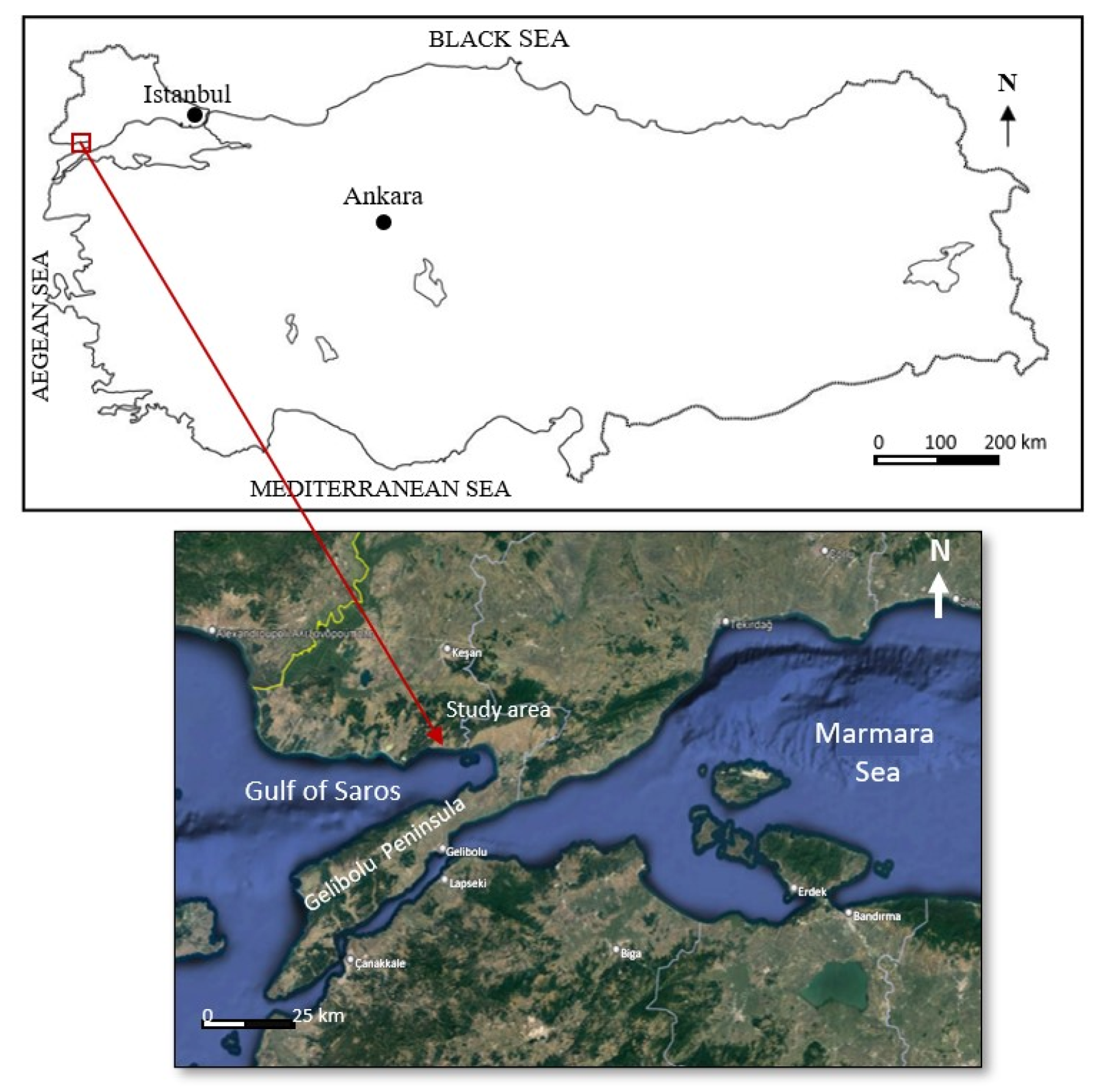
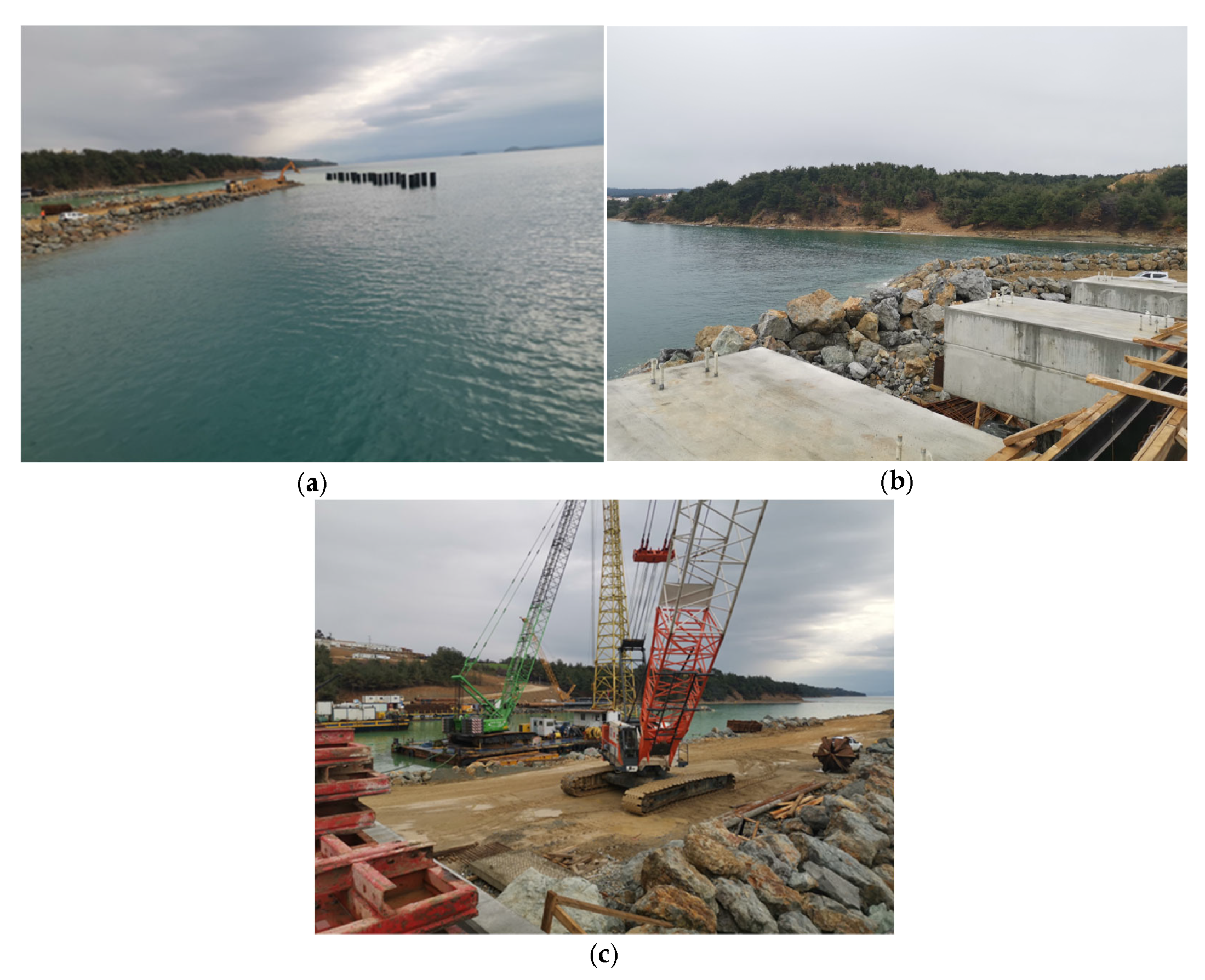
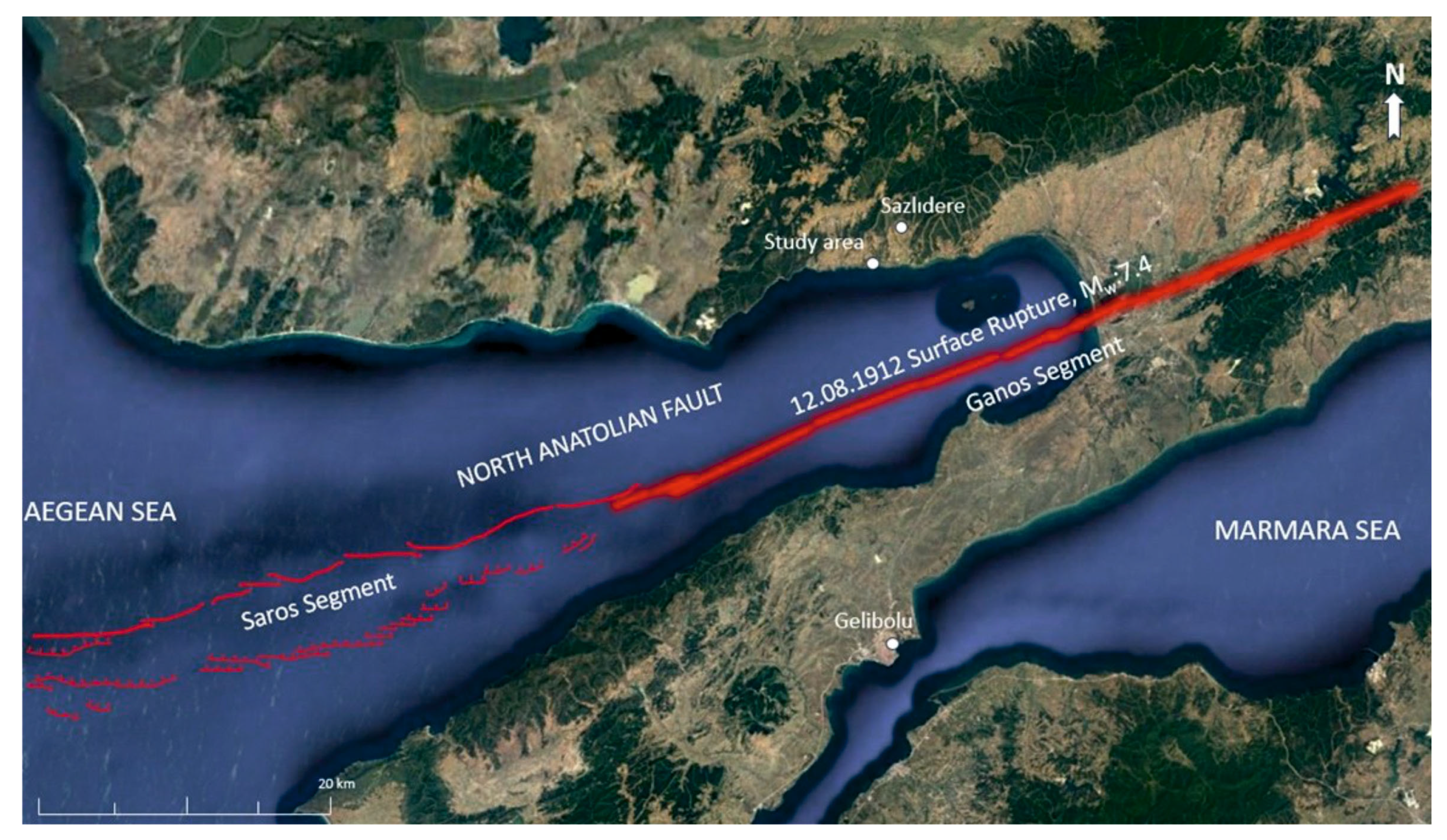
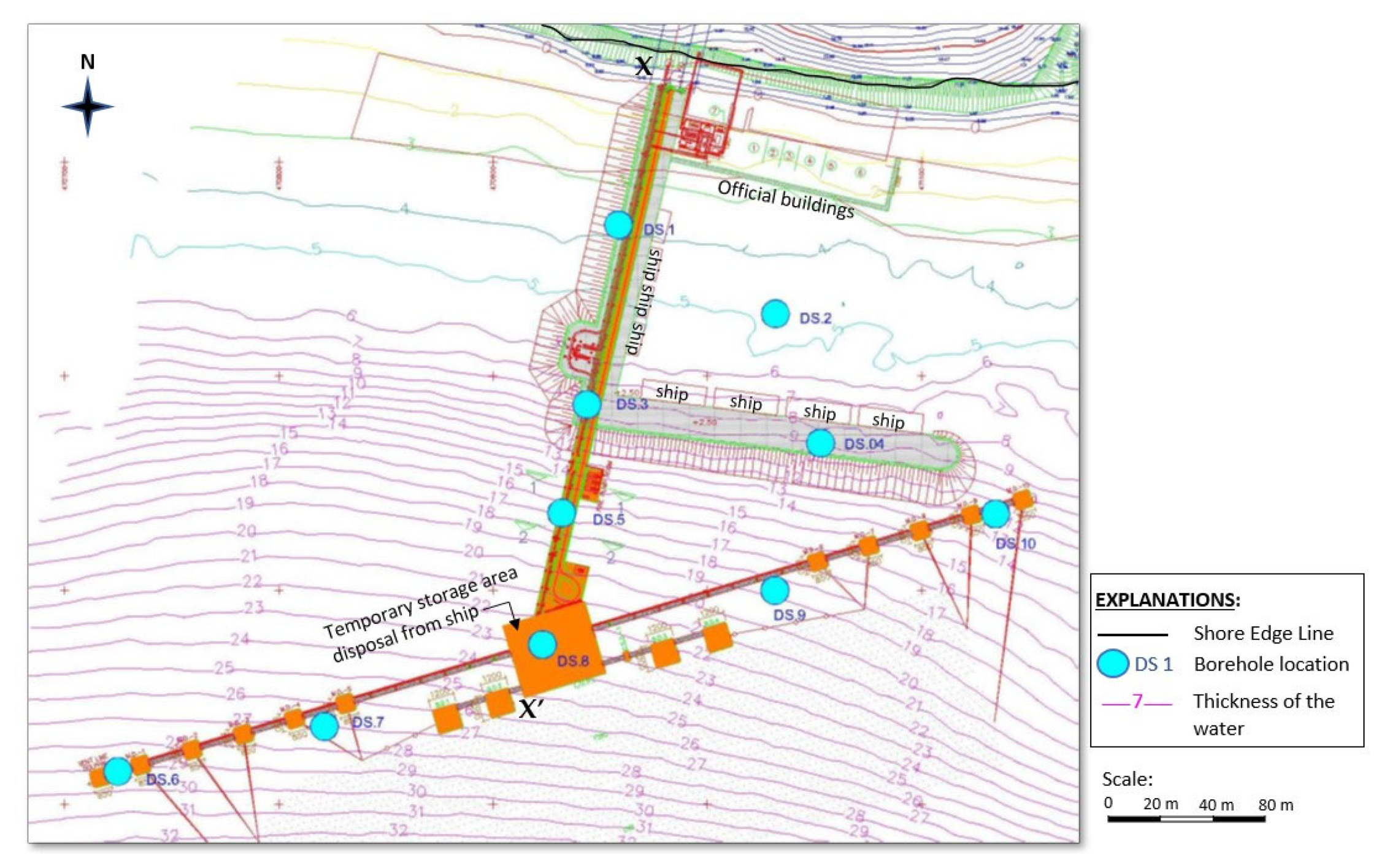

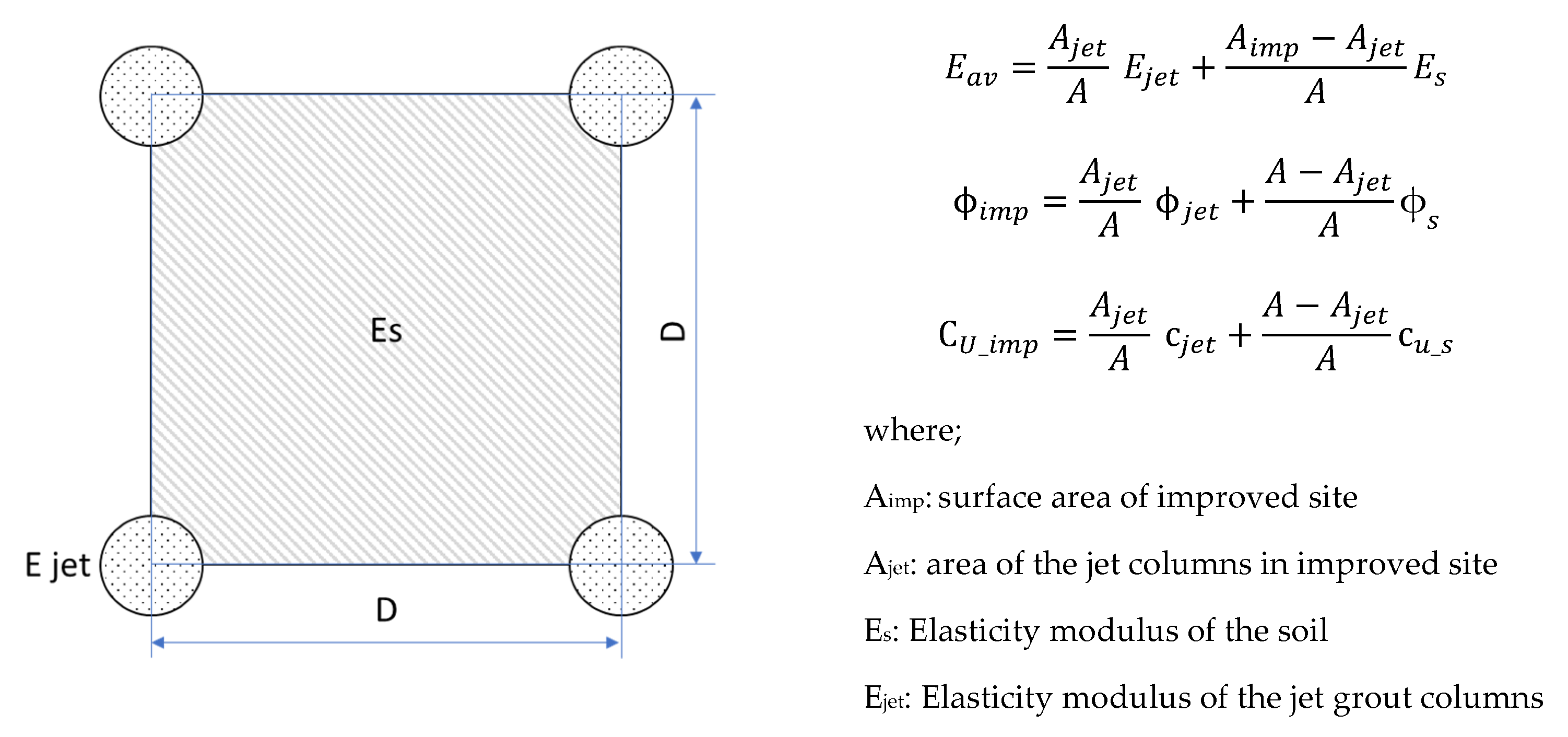
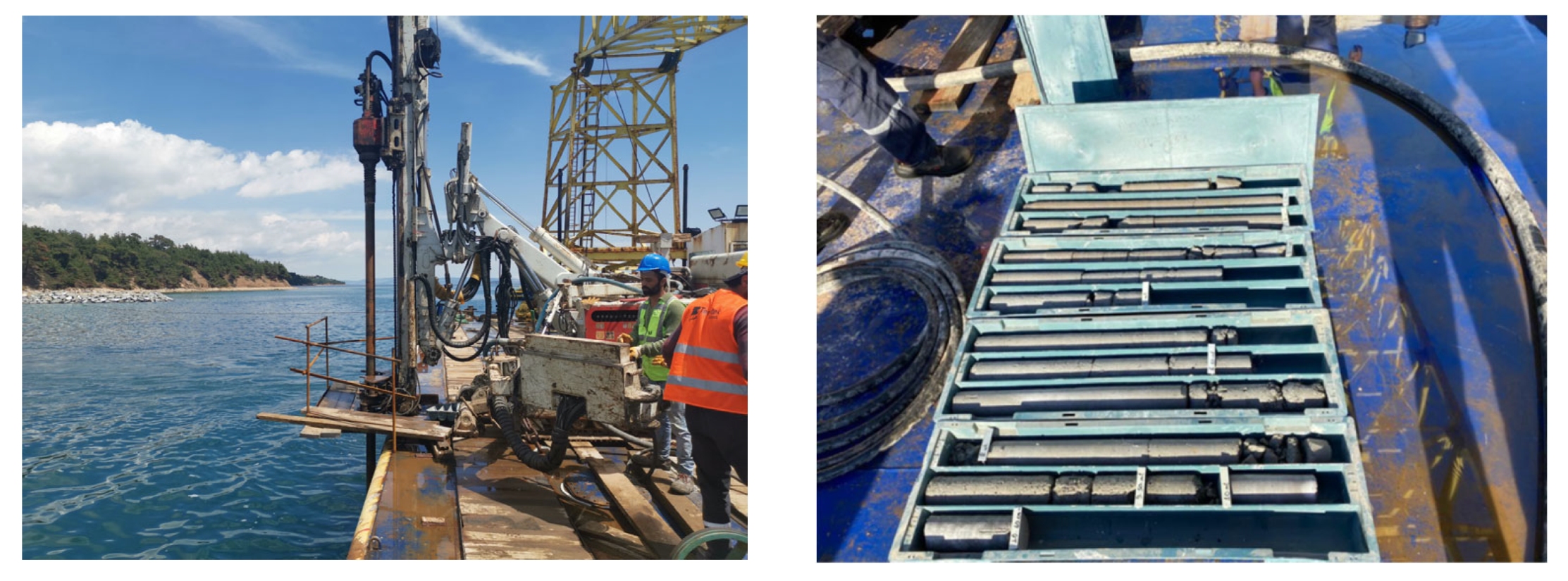
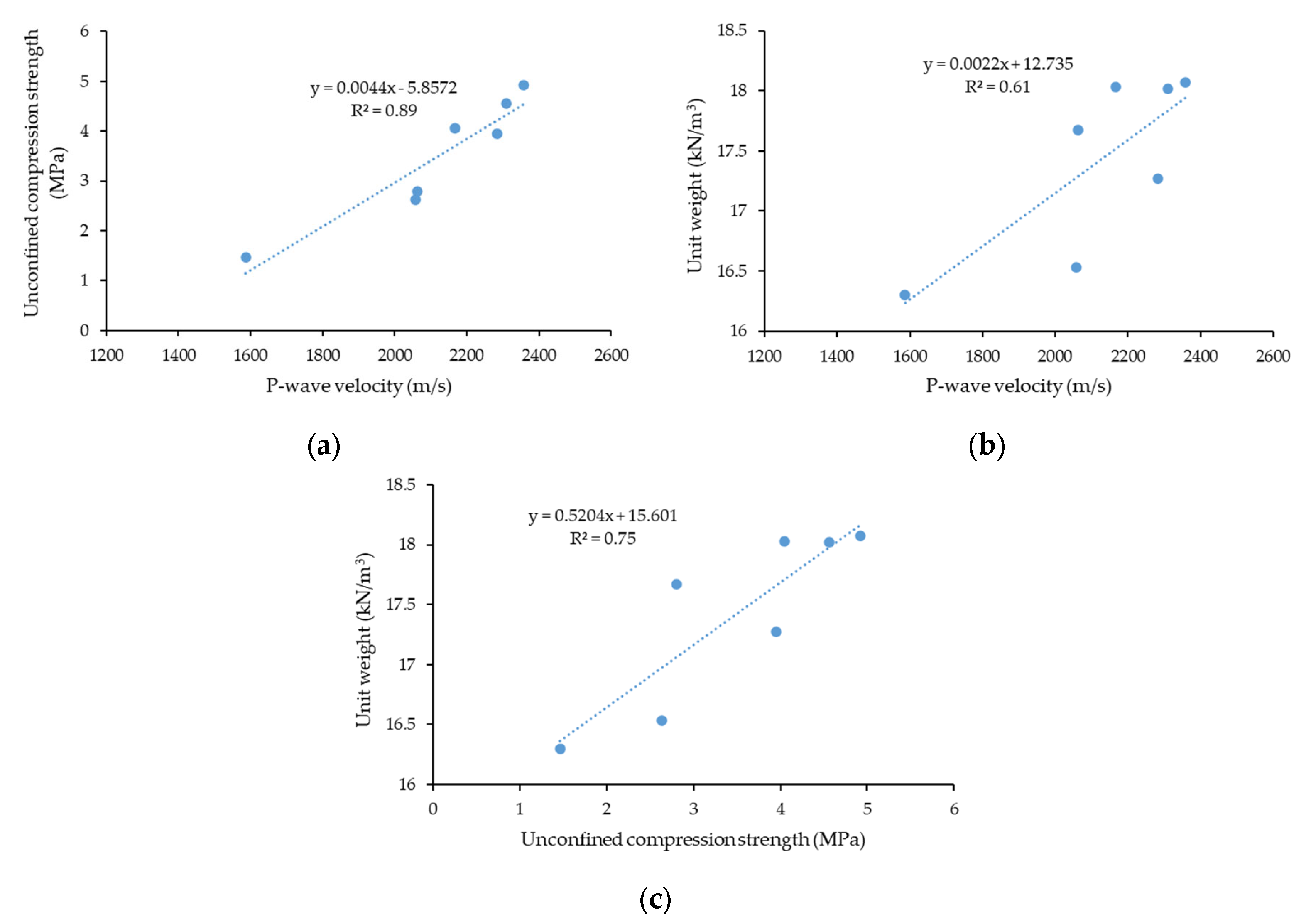
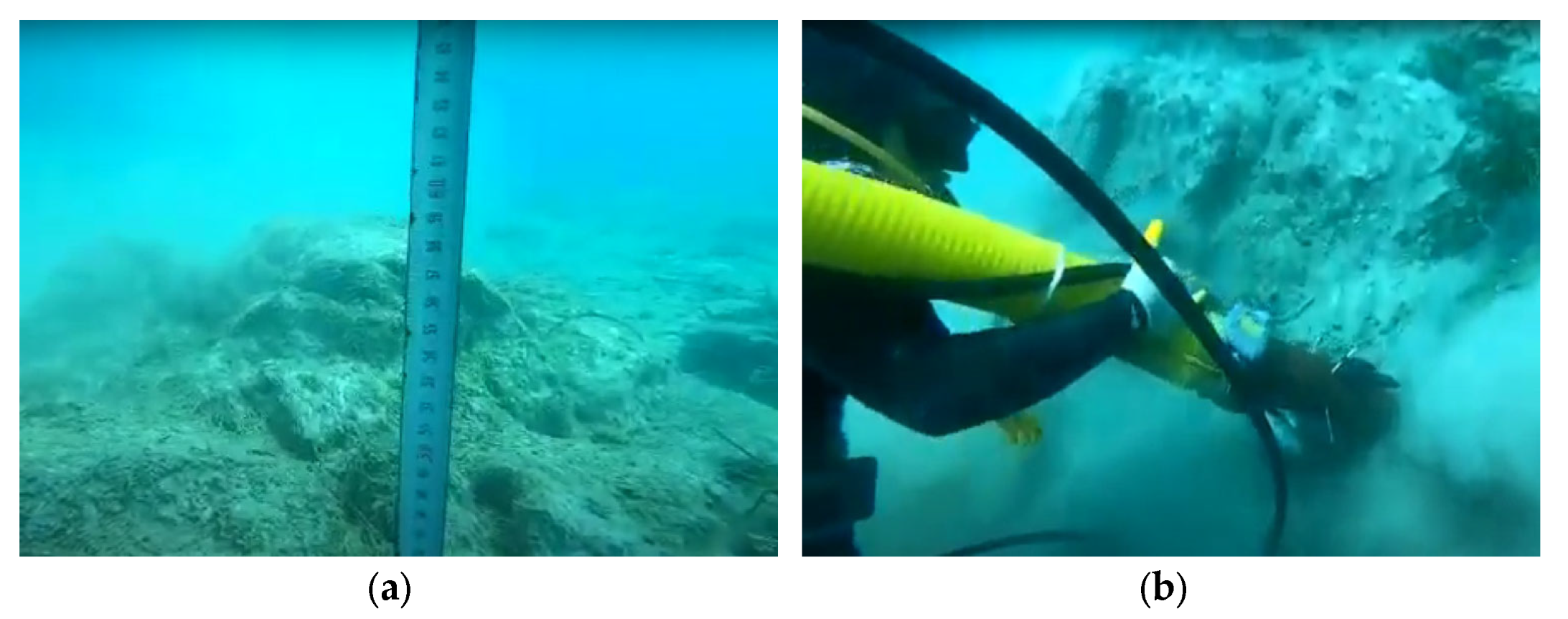
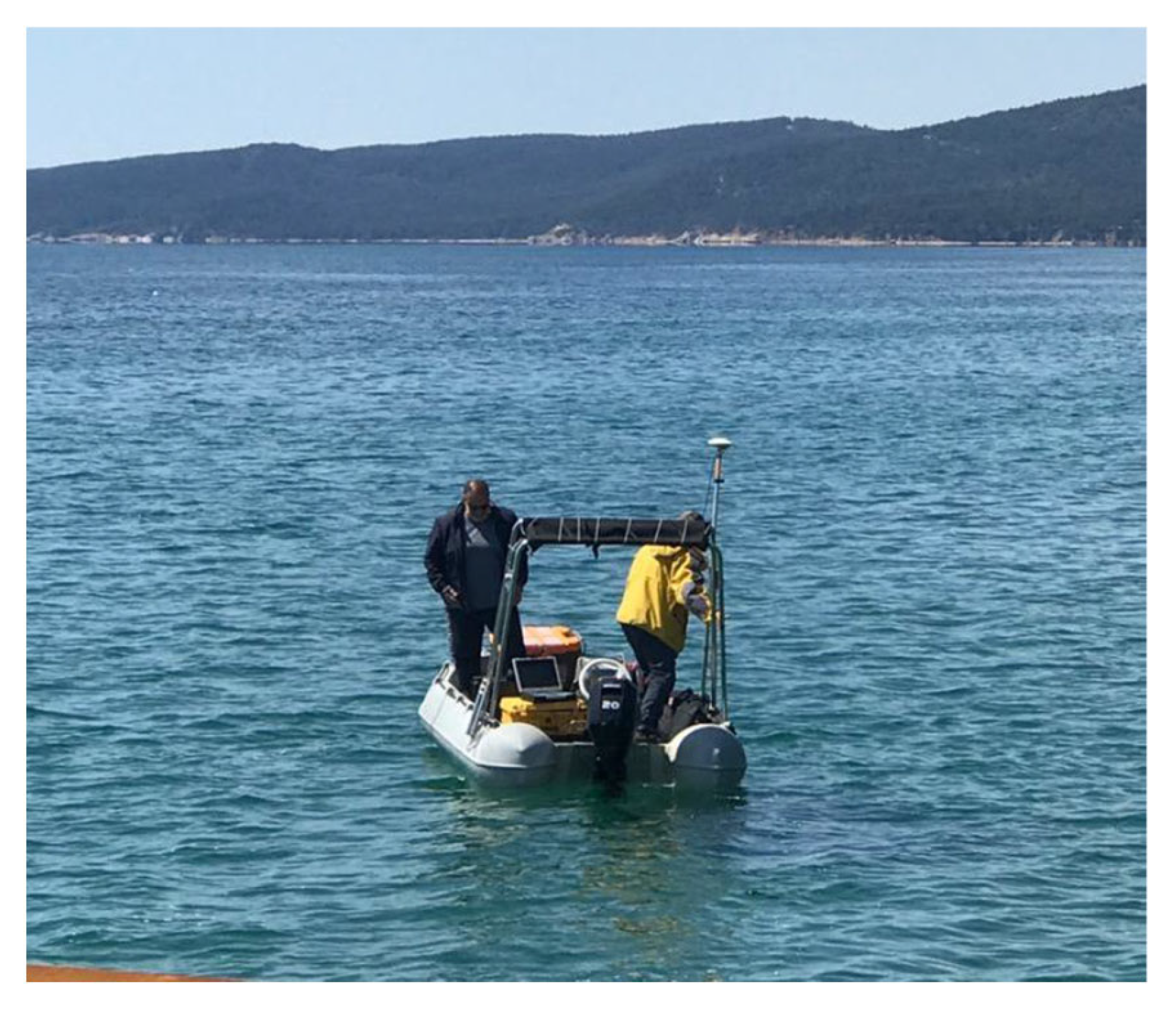
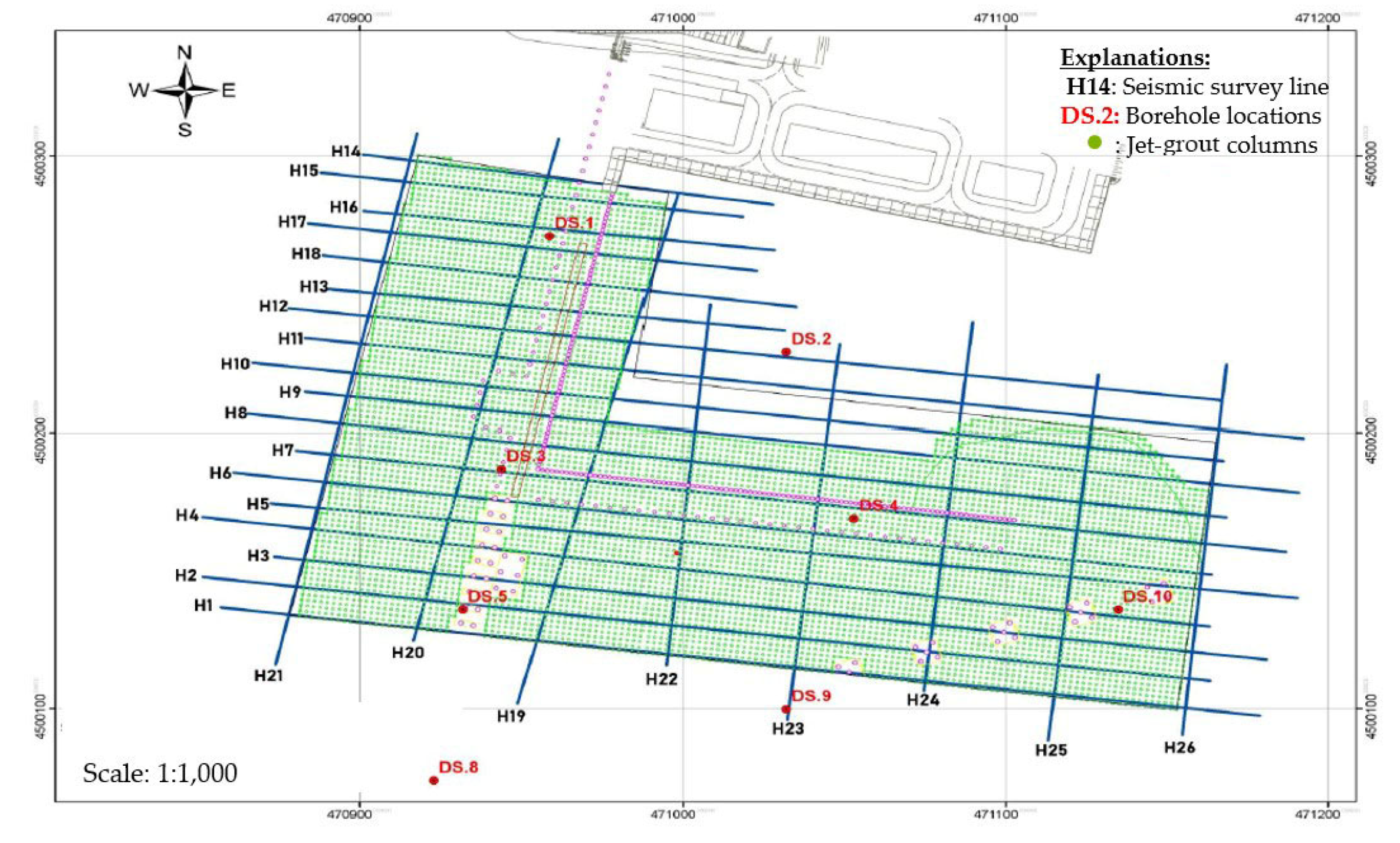
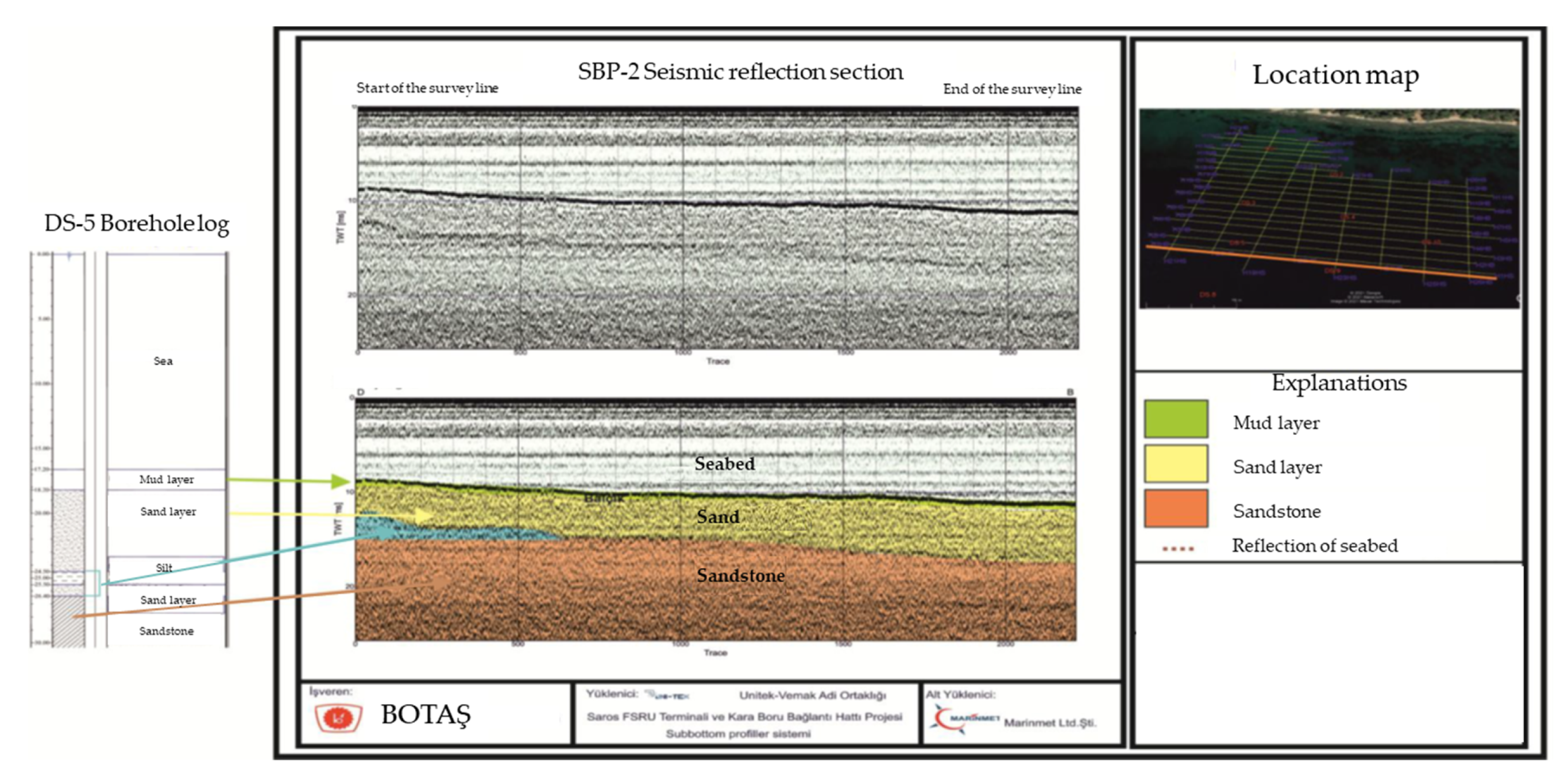
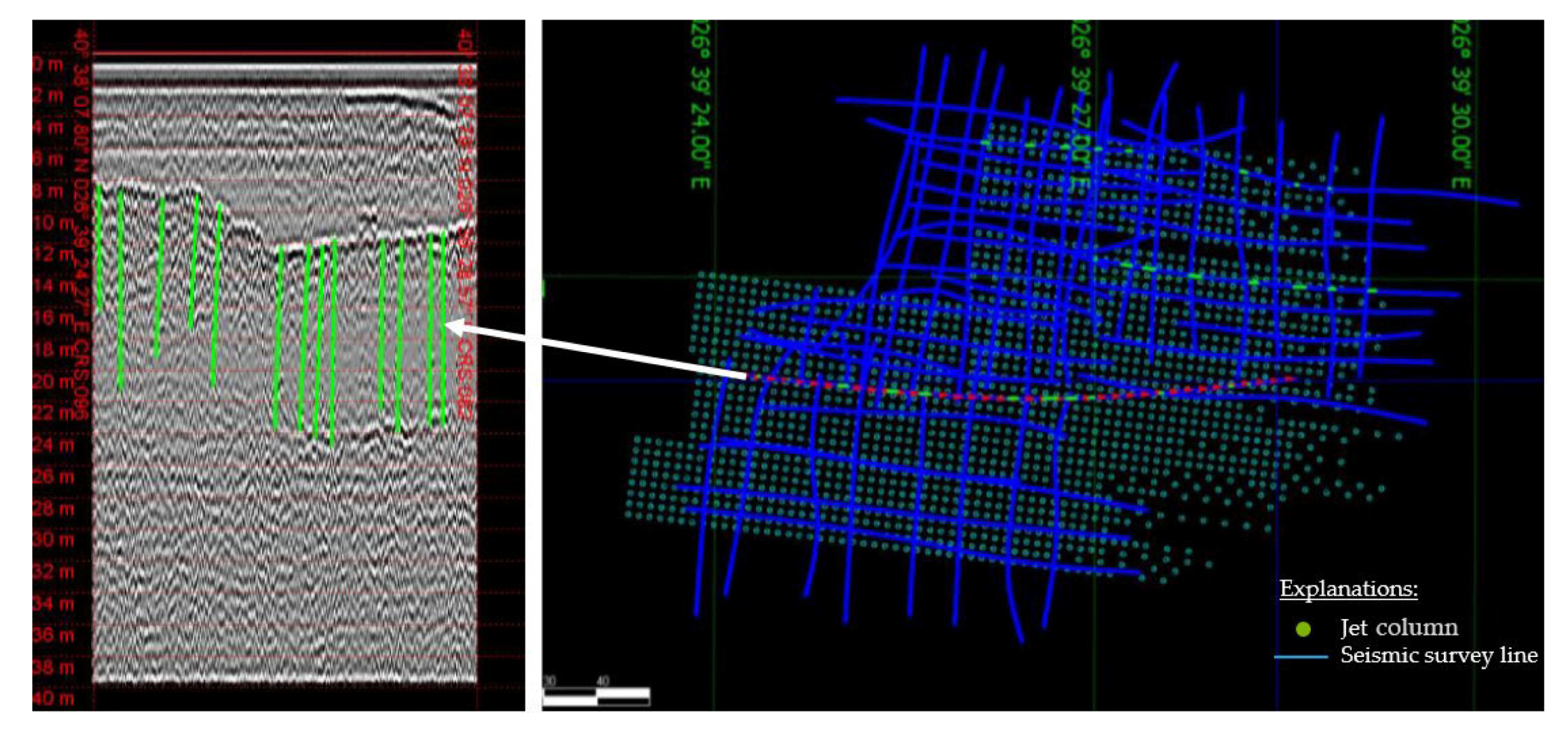


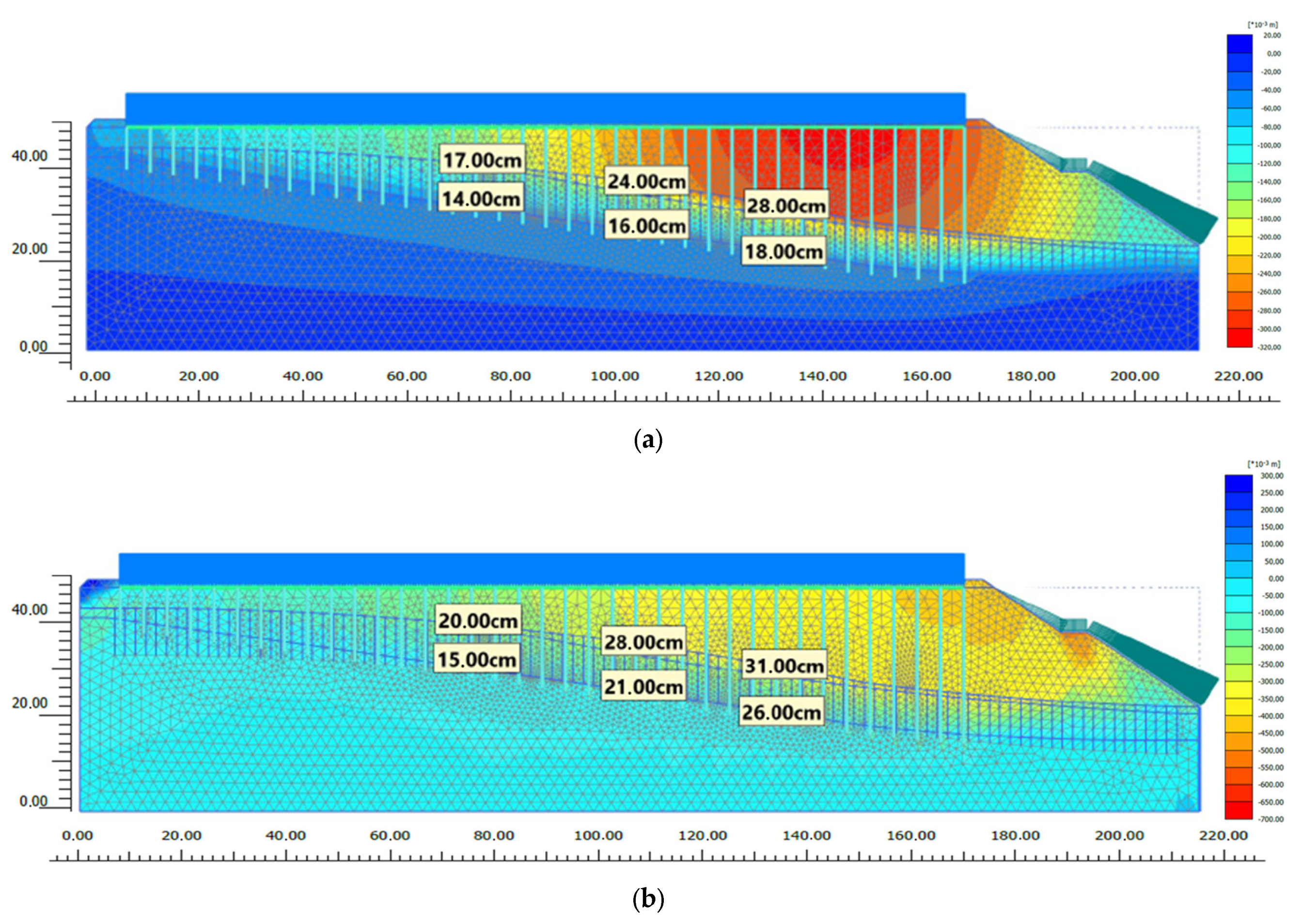
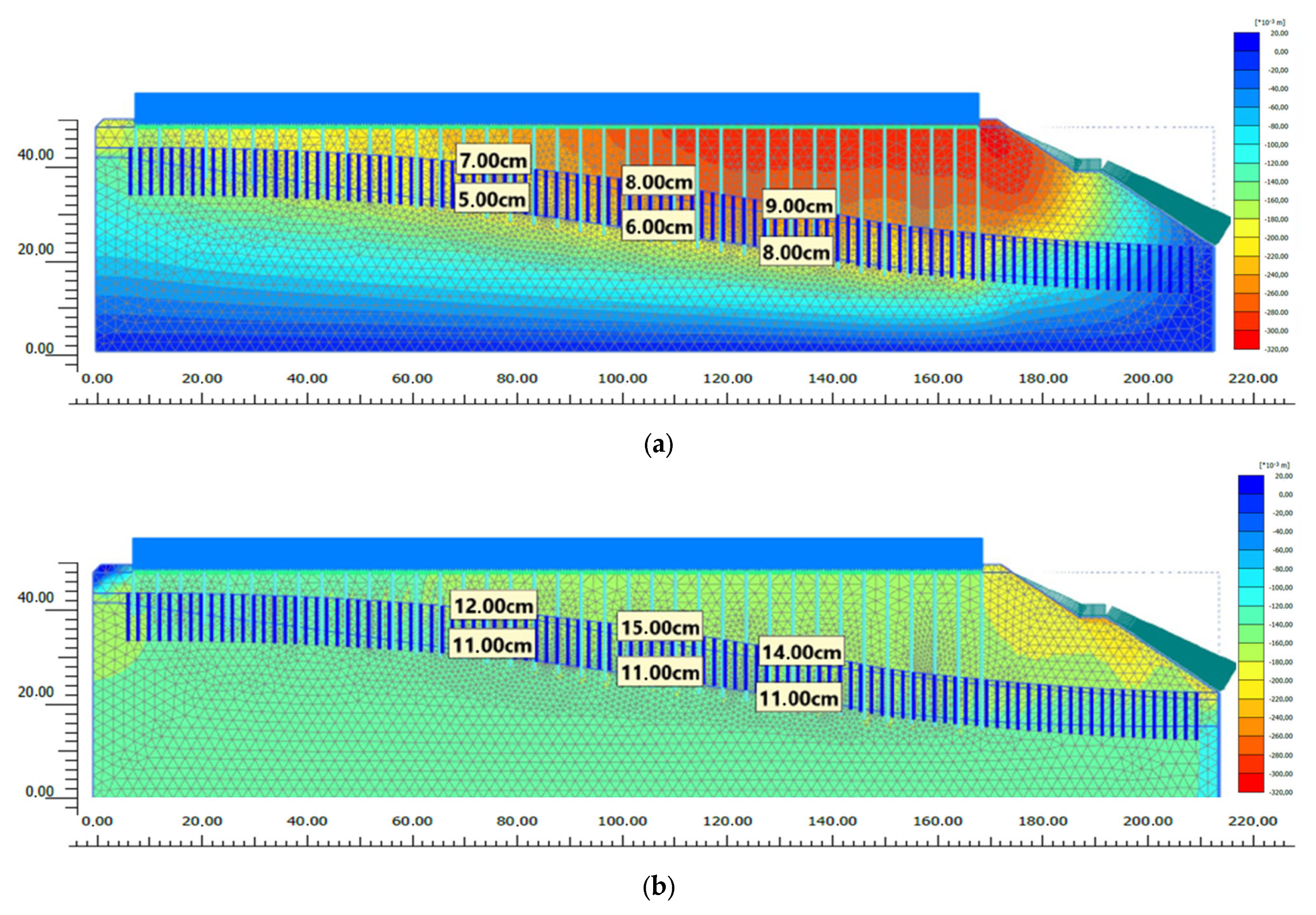
| Borehole No. | Depth of Boreholes (m) | Depth of Seabed (m) | Lithologic Units (Depth from the Surface, m) | SPT-N30 | RQD (%) |
|---|---|---|---|---|---|
| DS-1 | 24 | 4 | Loose sand (4 m–5.8 m) | 10 | - |
| Sandstone (5.8 m–24 m) | - | 10–53 | |||
| DS-2 | 24.8 | 4.8 | Loose sand (4.8 m–7.5 m) | 2–4 | - |
| Moderately dense sand (7.5 m–12 m) | 12–16 | - | |||
| Sandstone (12 m–24.8 m) | - | 13–100 | |||
| DS-3 | 28.2 | 9.1 | Loose sand (9.1 m–10 m) | 2 | - |
| Moderately dense sand (10 m–18.3 m) | 13–23 | - | |||
| Sandstone (18.3 m–28.2 m) | - | 30–70 | |||
| DS-4 | 28.2 | 8.1 | Loose sand (8.1 m–11.5 m) | 4–8 | - |
| Moderately dense sand (11.5 m–17.2 m) | 12–21 | - | |||
| Sandstone (17.2 m–28.2 m) | - | 7–40 | |||
| DS-5 | 31.5 | 18.2 | Moderately dense sand (17.2 m–26.4 m) | 8–41 | - |
| Sandstone (26.4 m–31.5 m) | - | 19 | |||
| DS-6 | 49.0 | 29.0 | Loose sand (30.0 m–34.2 m) | 5–9 | - |
| Sandstone (34.2 m–49.0 m) | - | 6–44 | |||
| DS-7 | 47.5 | 27.6 | Loose sand (29.2 m–33.5 m) | 4 | - |
| Sandstone (33.5 m–47.6 m) | - | 7–30 | |||
| DS-8 | 43.0 | 22.9 | Loose sand (24.2 m–26.0 m) | 4 | - |
| Moderately dense sand (26.0 m–29.3 m) | 10–11 | - | |||
| Sandstone (29.3 m–43.0 m) | - | 10–33 | |||
| DS-9 | 38.7 | 18.7 | Moderately dense sand (19.5.0 m–27.3 m) | 9–20 | - |
| Sandstone (27.3 m–38.7 m) | - | 8–87 | |||
| DS-10 | 32.0 | 12.0 | Loose sand (12.0 m–13.5 m) | 1 | - |
| Moderately dense sand (13.5 m–18.3 m) | 9–10 | - | |||
| Sandstone (18.3 m–32.0 m) | - | 9–20 |
| Borehole No | Depth (m) | SPT-N | Soil Type | g (kN/m3) | Fine Grain Content | Corrected SPT-N | Corrected SPT-N Value for Fines Content (N1,60f) | Safety Condition against Liquefaction (tr/teq > 1.10) | Liquefaction Potential | ||||
|---|---|---|---|---|---|---|---|---|---|---|---|---|---|
| Liquefaction Potential Index | Liquefaction Severity Index | ||||||||||||
| DS-2 | 0.4 | 2 | SM | 18 | 0 | 3.1 | 3.1 | 0.04 | liq. expected. | 10.93 | 11.38 | ||
| 1.9 | 4 | SM | 18 | 2 | 6.1 | 6.1 | 0.06 | liq. expected. | 13.29 | 14.14 | |||
| 3.4 | 12 | SP-SM | 18 | 2 | 20.8 | 20.8 | 0.15 | liq. expected. | 11.06 | 13.01 | |||
| 4.9 | 16 | SW-SM | 18 | 1 | 28.2 | 28.2 | 0.24 | liq. expected. | 9.03 | 11.86 | |||
| 6.4 | 15 | SW-SM | 18 | 1 | 23.1 | 23.1 | 0.17 | liq. expected. | 9.23 | 11.12 | |||
| LI = 54 | Very High | Ls = 62 | Moderate | ||||||||||
| DS-4 | 0.5 | 4 | SW | 18 | 0 | 6.1 | 6.1 | 0.05 | liq. expected. | 10.32 | 10.86 | ||
| 1.7 | 4 | SW | 18 | 7 | 6.1 | 6.1 | 0.06 | liq. expected. | 11.99 | 12.76 | |||
| 3.2 | 8 | SW | 18 | 0 | 13.9 | 13.9 | 0.10 | liq. expected. | 11.85 | 13.16 | |||
| 4.7 | 12 | SM | 18 | 1 | 21.6 | 21.6 | 0.15 | liq. expected. | 10.23 | 12.03 | |||
| 6.2 | 19 | SM | 18 | 1 | 29.7 | 29.7 | 0.29 | liq. expected. | 7.75 | 10.86 | |||
| 7.7 | 21 | SM | 18 | 1 | 29.5 | 29.5 | 0.29 | liq. expected. | 6.72 | 9.42 | |||
| 9.1 | R | SM | 18 | 1 | _ | _ | _ | _ | _ | _ | |||
| LI = 59 | Very High | Ls = 69 | High | ||||||||||
| DS-6 | 1.9 | 6 | ML | 18 | 59 | 9.2 | 9.2 | 0.11 | liq. expected. | 21.62 | 24.29 | ||
| 3.2 | 5 | ML | 18 | _ | 8.7 | 8.7 | 0.07 | liq. expected. | 11.36 | 12.21 | |||
| 4.7 | 9 | ML | 18 | 53 | 16.2 | 24.4 | 0.18 | liq. expected. | 8.23 | 10.03 | |||
| LI = 41 | Very High | Ls = 47 | Moderate | ||||||||||
| DS-10 | 0.7 | 1 | SM | 18 | _ | 1.5 | 1.5 | 0.04 | liq. expected. | 13.68 | 14.25 | ||
| 2.2 | 10 | SM | 18 | 13 | 15.3 | 17.9 | 0.12 | liq. expected. | 12.24 | 13.91 | |||
| 3.7 | 9 | SM-SC | 18 | _ | 15.6 | 15.6 | 0.11 | liq. expected. | 11.38 | 12.79 | |||
| 5.2 | 9 | SM-SC | 18 | 24 | 15.4 | 21.3 | 0.15 | liq. expected. | 12.23 | 14.38 | |||
| LI = 50 | Very High | Ls = 55 | Moderate | ||||||||||
| Unimproved | Improved | |||||
|---|---|---|---|---|---|---|
| c (kN/m2) | Φ (°) | E (kN/m2) | c (kN/m2) | ϕ (°) | E (kN/m2) | |
| Loose sand layer | 0 | 25 | 4750 | 38 | 26 | 41,852 |
| Moderately dense sand layer | 0 | 30 | 8250 | 38 | 31 | 44,912 |
| Jet No. | Length of the Jet-Column (m) | Depth of the Water (m) | Injection Pressure (bar) | Injection Flow Rate (L/min) | Withdrawal Speed (cm/min) | Amount of Mixture (kg) | Amount of Cement(kg) | The Length of Core Samples (m) |
|---|---|---|---|---|---|---|---|---|
| TC-19 | 10.3 | 7.20 | 430 | 54 | 35 | 5000 | 2500 | 1.5 |
| TC-26 | 10.1 | 7.40 | 440 | 54 | 40 | 4667 | 2334 | 10.1 |
| TC-35 | 10.3 | 7.40 | 420 | 53 | 40 | 4400 | 2200 | 10.3 |
| TC-37 | 10.3 | 7.30 | 440 | 54 | 40 | 4450 | 2225 | 4.5 |
| TC-38 | 10.4 | 7.30 | 420 | 53 | 35 | 4600 | 2300 | 10.4 |
Disclaimer/Publisher’s Note: The statements, opinions and data contained in all publications are solely those of the individual author(s) and contributor(s) and not of MDPI and/or the editor(s). MDPI and/or the editor(s) disclaim responsibility for any injury to people or property resulting from any ideas, methods, instructions or products referred to in the content. |
© 2023 by the authors. Licensee MDPI, Basel, Switzerland. This article is an open access article distributed under the terms and conditions of the Creative Commons Attribution (CC BY) license (https://creativecommons.org/licenses/by/4.0/).
Share and Cite
Tunar Özcan, N.; Gokceoglu, C. A Novel Approach for Assessing the Performance of Offshore Ground Improvement in Floating Storage and Regasification Unit (FSRU) Terminal Construction. Appl. Sci. 2023, 13, 9245. https://doi.org/10.3390/app13169245
Tunar Özcan N, Gokceoglu C. A Novel Approach for Assessing the Performance of Offshore Ground Improvement in Floating Storage and Regasification Unit (FSRU) Terminal Construction. Applied Sciences. 2023; 13(16):9245. https://doi.org/10.3390/app13169245
Chicago/Turabian StyleTunar Özcan, Nazlı, and Candan Gokceoglu. 2023. "A Novel Approach for Assessing the Performance of Offshore Ground Improvement in Floating Storage and Regasification Unit (FSRU) Terminal Construction" Applied Sciences 13, no. 16: 9245. https://doi.org/10.3390/app13169245





